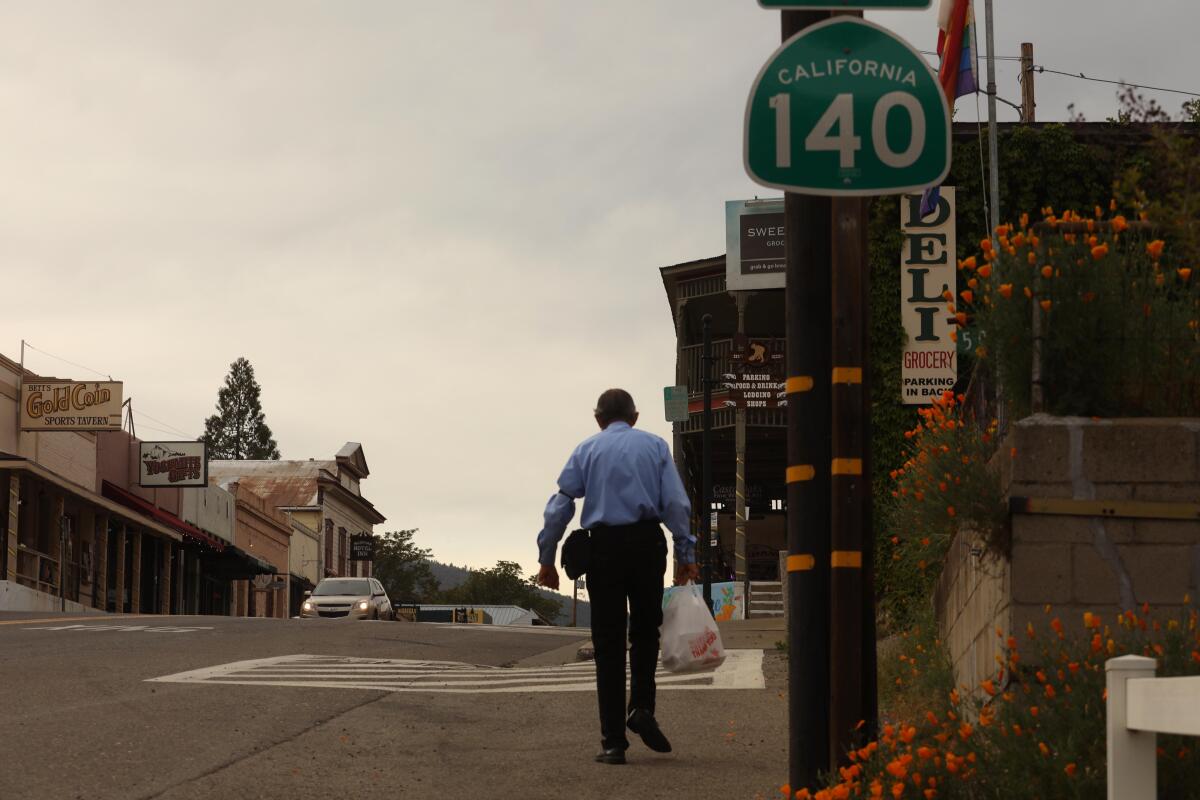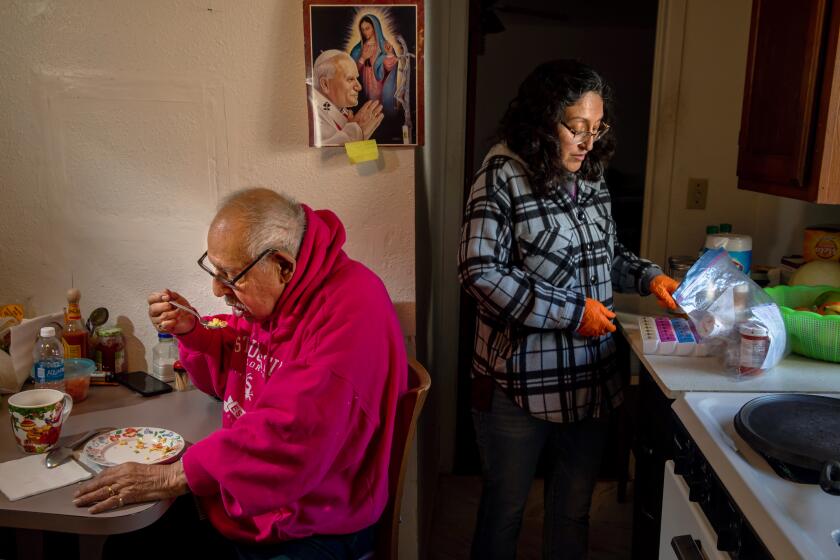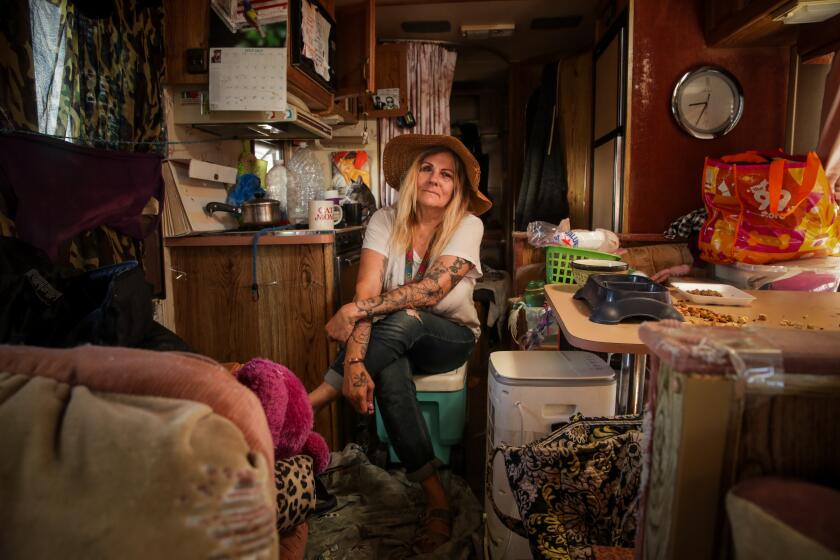What my grandma’s California trailer taught me about housing and elder care

- Share via
In the late 1990s, my family got a basement tenant: my grandmother. After years of aging largely alone in Los Angeles, she came north to join us in Petaluma. My mother moved out her sewing machines from the downstairs space she used as an art studio and moved in her fire-haired mother.
A year or so later, my grandmother — her trademark scoff robust as ever, my mom’s patience less so — moved into her own place. Housing options for elderly people in California were slim then, as now. For those with little to fall back on, such as retired public school teachers — my grandmother taught art — it was particularly tough. Lacking the nest egg of a home whose value had skyrocketed, or much savings at all, she ended up in that often-mocked American community: a trailer park.
My siblings and I went from being successful professionals to becoming round-the-clock caregivers in our late 50s. There aren’t enough home health aides nor can most families afford to pay them a good wage.
The Leisure Lake Mobile Home Park was my grandmother’s final home before she went into a care facility. She died in 2006, but I’ve been thinking about her final years lately, and about the ways we can age.
The park was, and still appears to be, a nicely landscaped warren of narrow roads lined with trailers, and a faux lake running through the middle. Her neighbors were pleasant, or at least private.
What sticks in my mind is the location on a suburban island. On one side ran the highway out of town, on the other a high-speed country road. The hum of cars was a constant low vibration, the pollution a hazy scourge. The other sides gave way to a driving range and a seasonal pumpkin patch and corn maze.
You could not safely walk to or away from the park. The two-lane country road that provided an outlet was favored by diesel pickups and tractor-trailers. Walking beside it would have been a terrifying sensory assault — if there was a walkway. But there was no sidewalk or dirt path, just a narrow shoulder sloping into a ditch.
In short, if you could not drive, you were trapped. In my uncharitable moments, I wondered if that was the point: Put your car-less parents here. They will not escape.
Lopez: A looming crisis: the crushing cost of elder care and the crippling effects of low wages
She takes care of seven clients, works seven days a week and can’t afford to slow down -- one of thousands who multi-task for our aging population.
I left the Bay Area in 2019. Walking my dog in my current home of Barcelona, Spain, I often remember my grandmother. A few blocks away from me is the Residència Pare Batllori, an elder home. On a recent morning, two old men sitting out front reached over to pet my dog. Bon dia, we said to each other. I turned the corner, passed the popular nightclub and concert venue Teatre Apolo, and looked into the ground-floor windows of Residència Colisée Paral·lel, an assisted care facility. Through the glass I spotted a few senior women chatting in the rec room.
The park next door features bocce courts and a Saturday farmers market. A few blocks away is one of the city’s outdoor jewels, the Montjuic park, which still holds amenities from the 1980 Olympics. Within a couple blocks there’s a gym, bakery, yoga studio and several supermarkets. There’s a subway entrance a few paces from the door of one residence. Locals here not only have the basics within walking distance; they can go clubbing, too.
Density debates in the United States tend to focus on topics such as the climate emergency and the housing crisis — critical issues, of course. Yet I now see that those discussions are also about how we want to age. We are debating whether our future selves can live as part of society, and what it will take for families to come visit grandparents, parents and others.
As L.A. officials and residents push to get rid of RV encampments, one woman’s story reflects the mountainous obstacles faced by those who try to find housing.
There are walkable communities for older people in the U.S., and challenges to aging in Barcelona; too often money determines your comfort level. But my neighborhood reminds me daily that the options we give our elders are a choice. We can build for them to age near us and walk our streets. We’re just going to need enough housing to do so: more apartments, more density, more people in less space. In California especially, we need to rethink our single-family mandates, zoning restrictions and tendency to build out, not up, all of which foster isolation.
For about a year in my late teens, I spent most Saturday mornings ferrying my grandmother around town in her 1980s Toyota Celica, after her eyesight became too poor for driving. We went to Trader Joe’s to pick up port and eggnog, whenever they had it (she drank it yearround), to the library for movies and audio books (never Hemingway: “I cannot stand that man”), to the pharmacy for dye (to keep her hair aflame).
She would get all dressed up for each outing — lipstick, blush, silk blouse. It was clear she looked forward to it all week. That was probably in part about spending time with me. But it was also about getting off the island.
My dream is that by the time I am her age, living in the U.S. again and no longer driving, we will have fewer islands. I don’t want to be marooned — and I hope to still go dancing.
Michael Kavate writes the newsletter Cooler Futures and is a senior reporter with Inside Philanthropy.
More to Read
A cure for the common opinion
Get thought-provoking perspectives with our weekly newsletter.
You may occasionally receive promotional content from the Los Angeles Times.












